︎ARTSCIENCE
science communication and artistic languages
talk scientists artists researchers
projects ︎phonosynthesis | music from alien species︎m_CRO | antropocentric illusion destabilizer ︎ ash memories ︎sound fishing ︎RISORGIVA | endangered ecosystems ︎ΔT ︎ Wetland Designers
a/v analog synthesizer art
mondrian a/v system ︎#cleanNFT on Objkt.com
wandalumen live visuals
videomaking
︎ videoclips | docu | workshops
Scientists Artists Researchers
L. Moholy-Nagy, exponent artist of Bauhaus in Weimar, gave an organic vision of progress, focused on creativity:
“In every cultural period, a phalanx of active forces pushes forward in every field of creation, in art, science and technology. It often happens that swift action in one or another creative field pushes forward a single member of this united front, like an advancing wedge. This condition does not last long, because as a consequence of the progress of one element, the other members of the phalanx are also dragged along, and the front is thus reunited ”.
According to György Kepes, founder of the "Center for Advanced Visual Studies" at MIT, modern scientific research focuses less and less on the facts themselves and more and more on their interconnection, on the relationship between them.
STEM (Science, Technology, Engineering and Maths) acquire an extra letter, the “A” for Art. STEAM becomes a new pillar for today's education system.
Thus, in its evolution, science approaches art as a creative process based on interconnections and relationships with different disciplines.
Alongside this natural convolution between science and art we find a scientific community which, in making important decisions for scientific development, is increasingly linked to a partnership with various political, economic and therefore social groups.
Society increasingly needs to be informed about scientific and technological advances, which have become an integral and decisive part at every level, individual and collective, of citizens.
In this intertwining of relationships, communication becomes necessary, and artistic languages may represent a powerful tool for science communication and for cultural growth.
THE THIRD SPACE
In their paper “Emergent Knowledge in the Third Space of Art-Science”,
Lizzie Muller, Lynn Froggett, Jill Bennett write that Art and Science meet in the Third Space, a place that generates shared experiences, a time shared by scientists and artists where they can do CREATIVE RESEARCH.
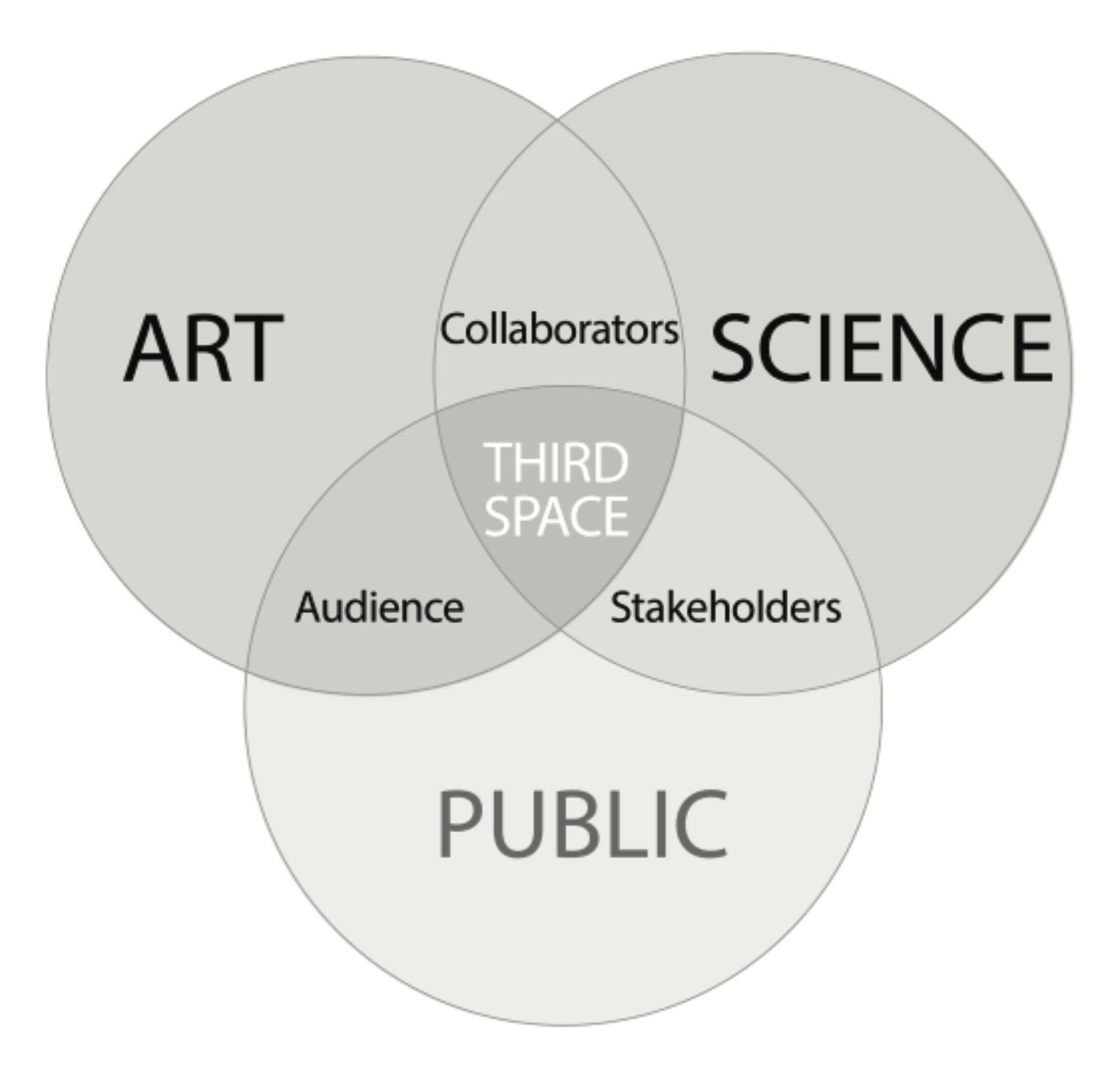
Within this space there is mutual growth: science rediscovers creativity in research processes and its fundamental role in serendipal discoveries, while art is capable of breaking the boundaries between different disciplines involved, exploring freely a scientific concept, elaborating and showing it to society.
COMMUNICATION: THE FORTH SPACE
What is created inside the third space resonates outside it and this creative process reverberates within the interested audiences (artistic, scientific and the publics). This cross-boundaries resonation creates the FORTH SPACE, a bridge through which different fields can communicate using art as common language.

Under this light the artistic language is, in its intrinsic expressive power, an added value for the communication of science.
It makes it possible to reach different audiences and thus contribute to the formation of a scientific citizenship: a society that is attentive, aware and critical of the scientific discoveries and the pervading technologies.
“The construction of scientific citizenship is an essential element of a democratic society of knowledge. And in the construction of scientific citizenship, the public communication of science is called to play the decisive role of lymphatic system"
Pietro Greco, scientific communicator

The project deals with a specific phenomenon linked to climate change, namely the growing number of invasive alien species (IAS).
IAS have the ability to rapidly expand to higher latitudes and to different altitudes as the climate warms and this process changes the biodiversity of affected areas, threatening local species.
These plants speak for themselves through an interactive sound-based artistic installation.


The first step is to collect the plants, this means walking the territory, sighting the different species and putting them in vases. At this stage we need a botanist or other scientist who can recognize the species. In my case, I asked Dr. Michela Sesso to join the project.
We have been in two different Nature Reserves near the city of Trieste, Italy.



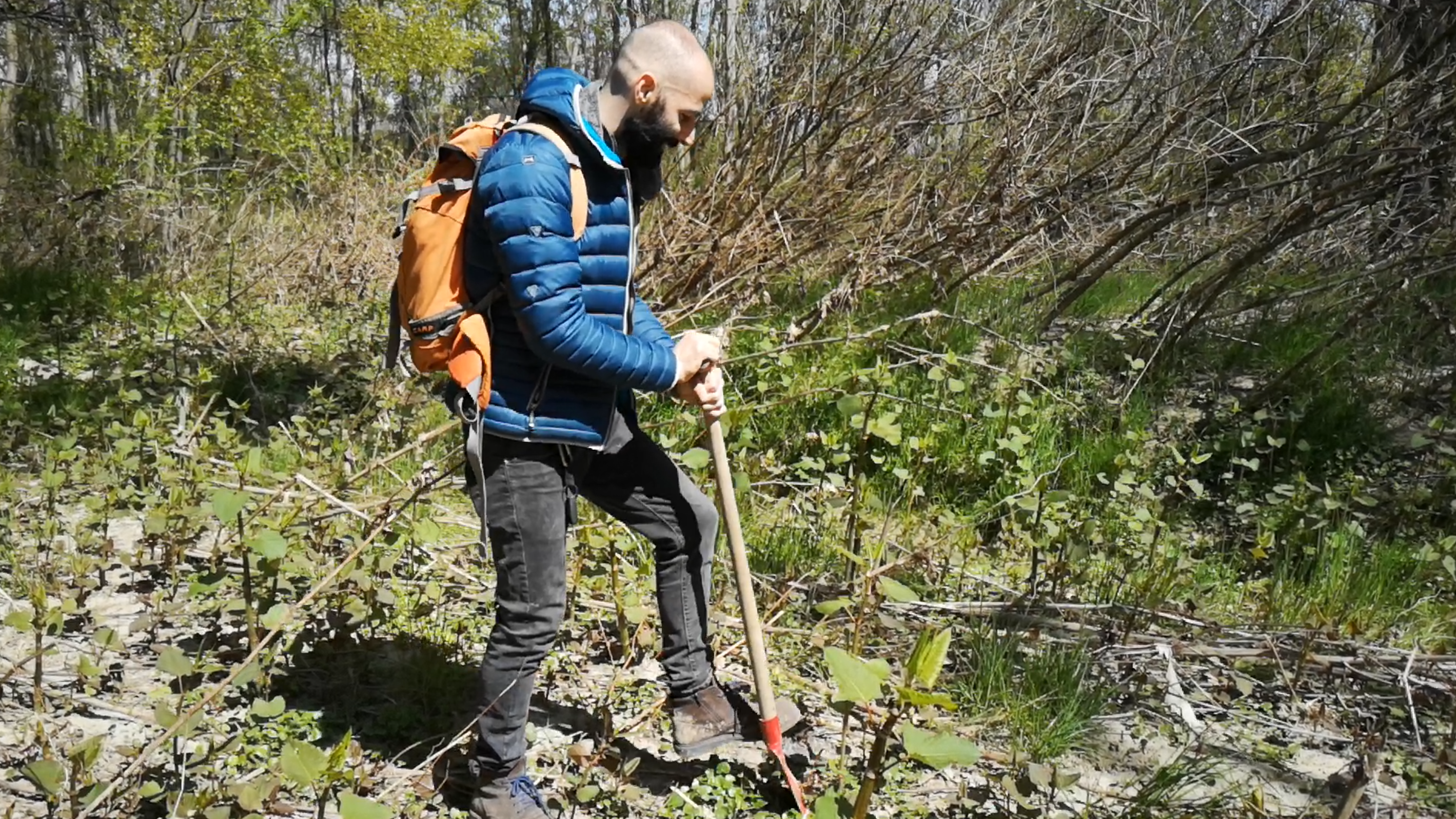

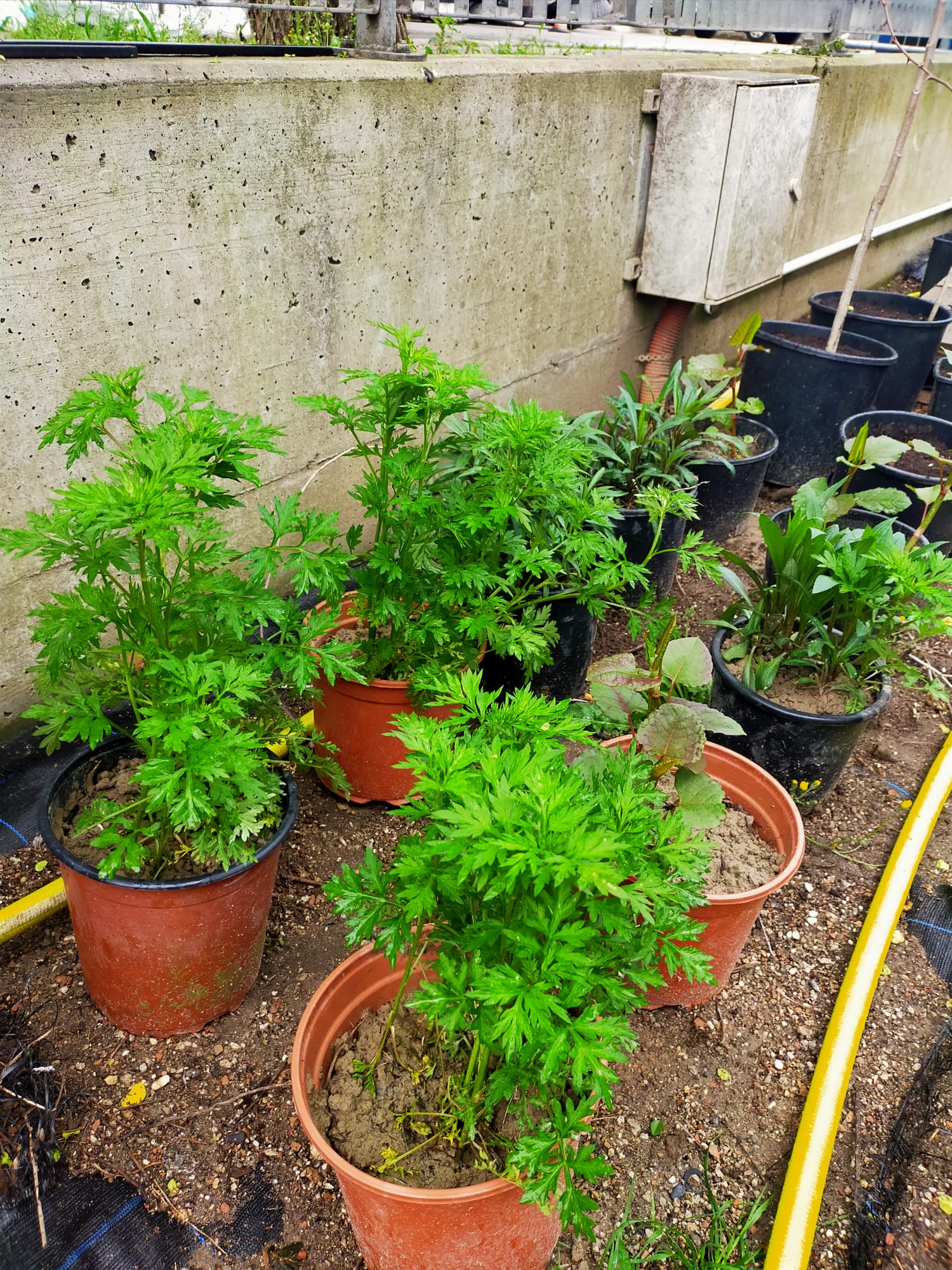

The second part consists in soldering several specific circuits led by Arduino chips and connect them to the plants. In this way a very small electric current passes through the plant. The amount of water, wind and human touch can affect that electric current, producing data that can be associated with different musical notes played by electronic instruments or computer softwares.

Each alien species has been assigned to a particular musical instrument typical of the plant's country of origin. So, for example, Reynoiutra Japonica was playing Koto, while to Robinia Pseudoacacia, a native of the Appalachian Mountains, was assigned Native American songs.

Third step: all the collected species are exhibited in an interactive installation. The public is invited to play the plants by touching them, producing a beautiful sound environment and creating the perfect opportunity for an informal debate on climate change.


The goal of "Phonosynthesis: music from alien species" is to communicate a specific aspect of climate change.
The interactive art installation becomes a way to grab the attention of different people of all ages.
The project can also be set up as a workshop program to be proposed within schools or other communities, acting locally but talking about a global problem.
Exhibitions
Scienza e Virgola Festival 2021 - Trieste
Selected for CMCC Climate Change Communication Award "Rebecca Ballestra" 2021
Trieste Film Festival 2022
Far East Film Festival - Udine 2022
Phonosynthesis
a project by Francesco Scarel
music Andrea Gulli
botanist Michela Sex
coding advice Alessandro Fontana
handmade book Annamaria Sgubin
developed for
SISSA - International Higher School of Advanced Studies
in collaboration with
MCS Master in Science Communication
Dobialab
2021
È temerità chiamar vano o superfluo
tutto quello dell'universo
che non serve per noi
Galileo Galilei
che non serve per noi
Galileo Galilei
Subject conceived together with students of the Master in Science Communication “F. Prattico ” in SISSA, year 2021/2022 during the course “ArtScience, communicating science through artistic languages”.
m_CRO is an artistic installation created together with scientists and various Research Centers of Friuli Venezia Giulia. It invites us to ask ourselves about anthropocentrism, or rather the tendency of man to consider himself at the center of the world in which he lives.
The microscopic and the macroscopic are equalized and placed at the same dimensional level: the action of observing, combined with the sensation of being observed, wants to destabilize our egocentric vision in favor of a more "ecocentric" existence.
We are only a small part of something bigger than us.
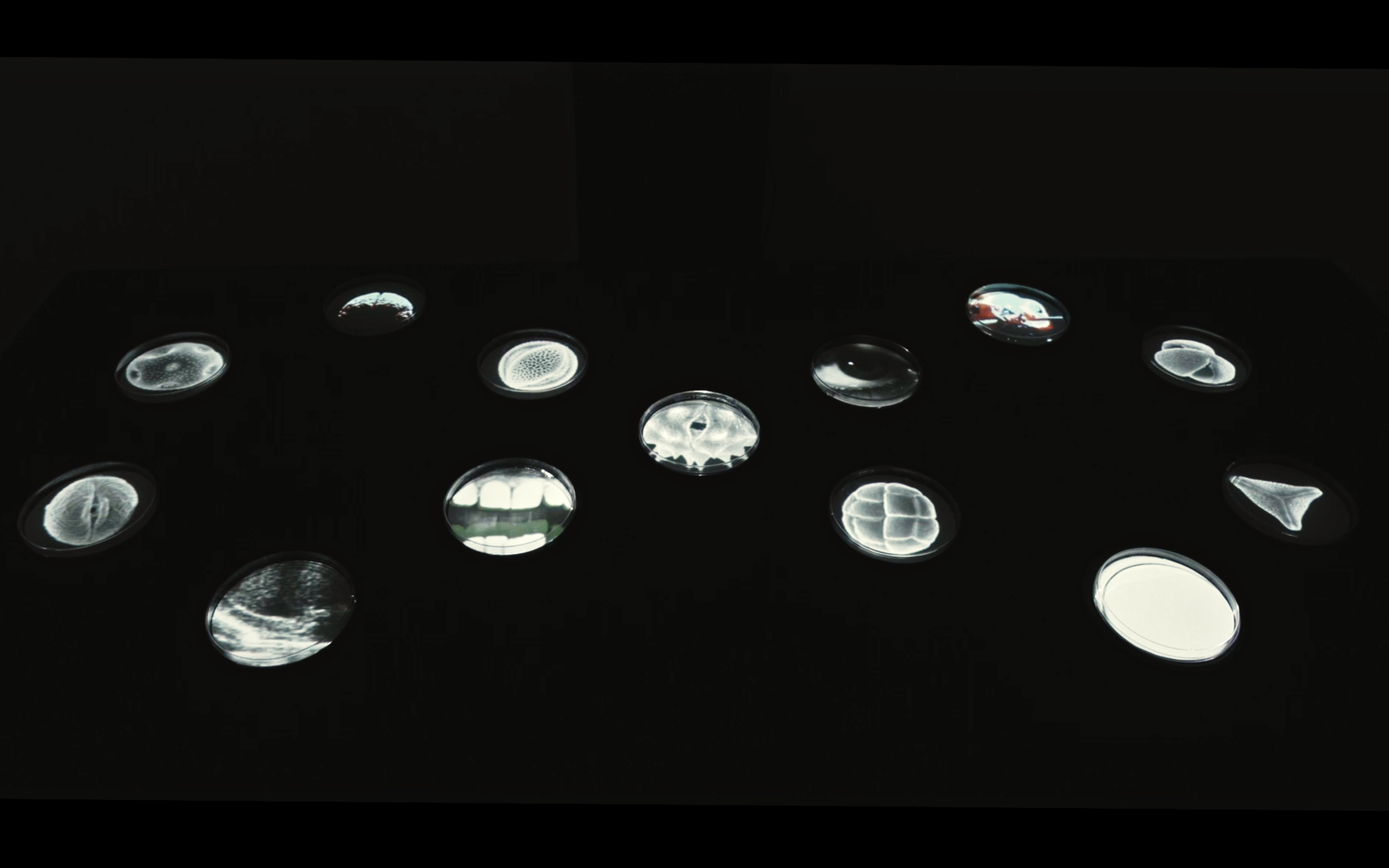
The microscopic and the macroscopic are equalized and placed at the same dimensional level: the action of observing, combined with the sensation of being observed, wants to destabilize our egocentric vision in favor of a more ecocentric existence.
m_CRO project uses videomapping technique with a zenithal projection on a table: different images are projected inside Petri dishes, disc-shaped containers usually used by scientists to grow mold and bacteria cultures.
In science labs the Petri dish is a container of microworlds observable under the microscope: a small place where the action of observing is focused on a unidirectional level, that is, from man to microorganism, from MACRO to MICRO.
This one-sidedness of the gaze inevitably places us at the center of the world in which we live: as observers, we take on the role of absolute protagonists of the environment in which we exist.
With this installation we intend to trigger a short circuit in our way of relating to the environment.


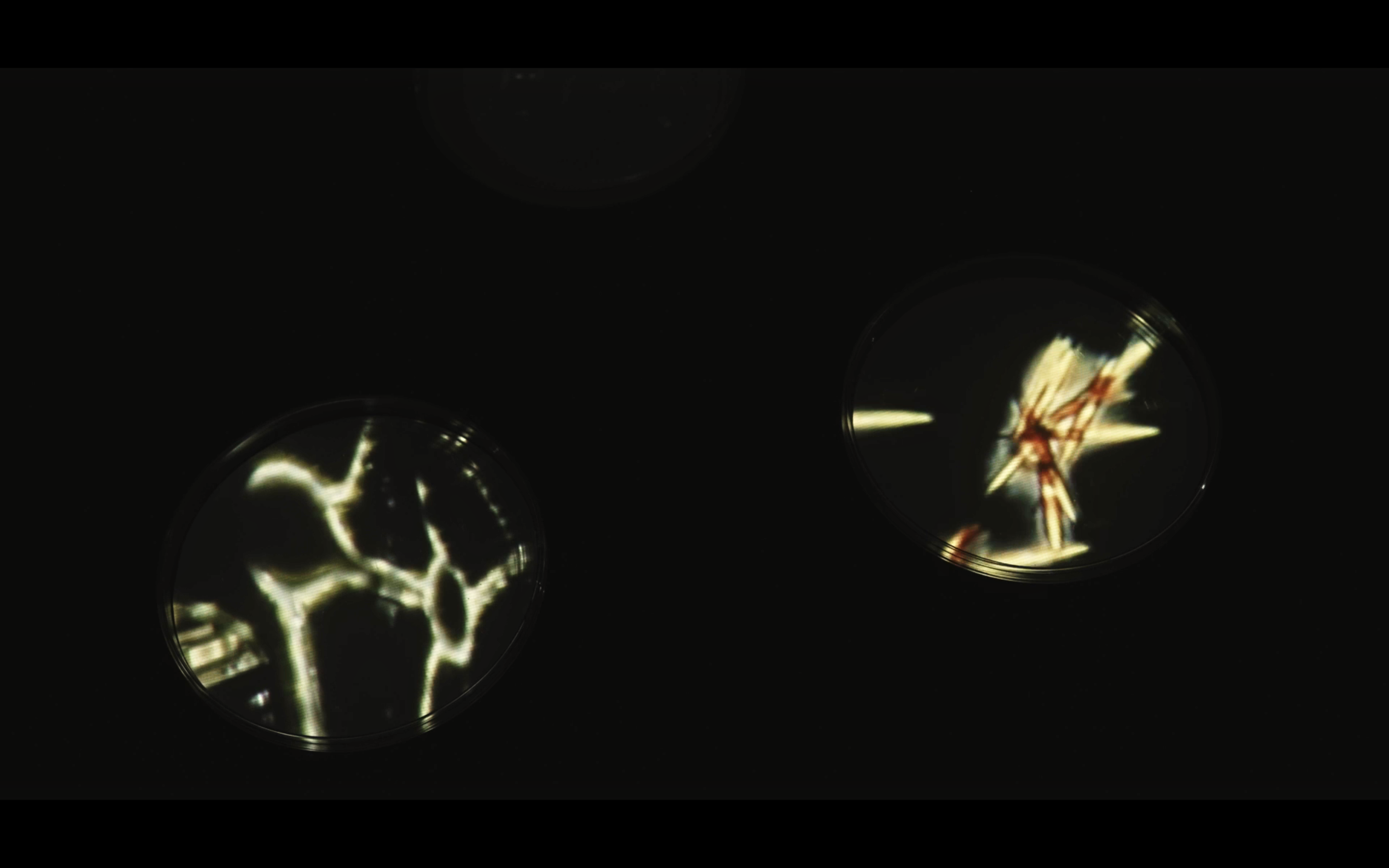


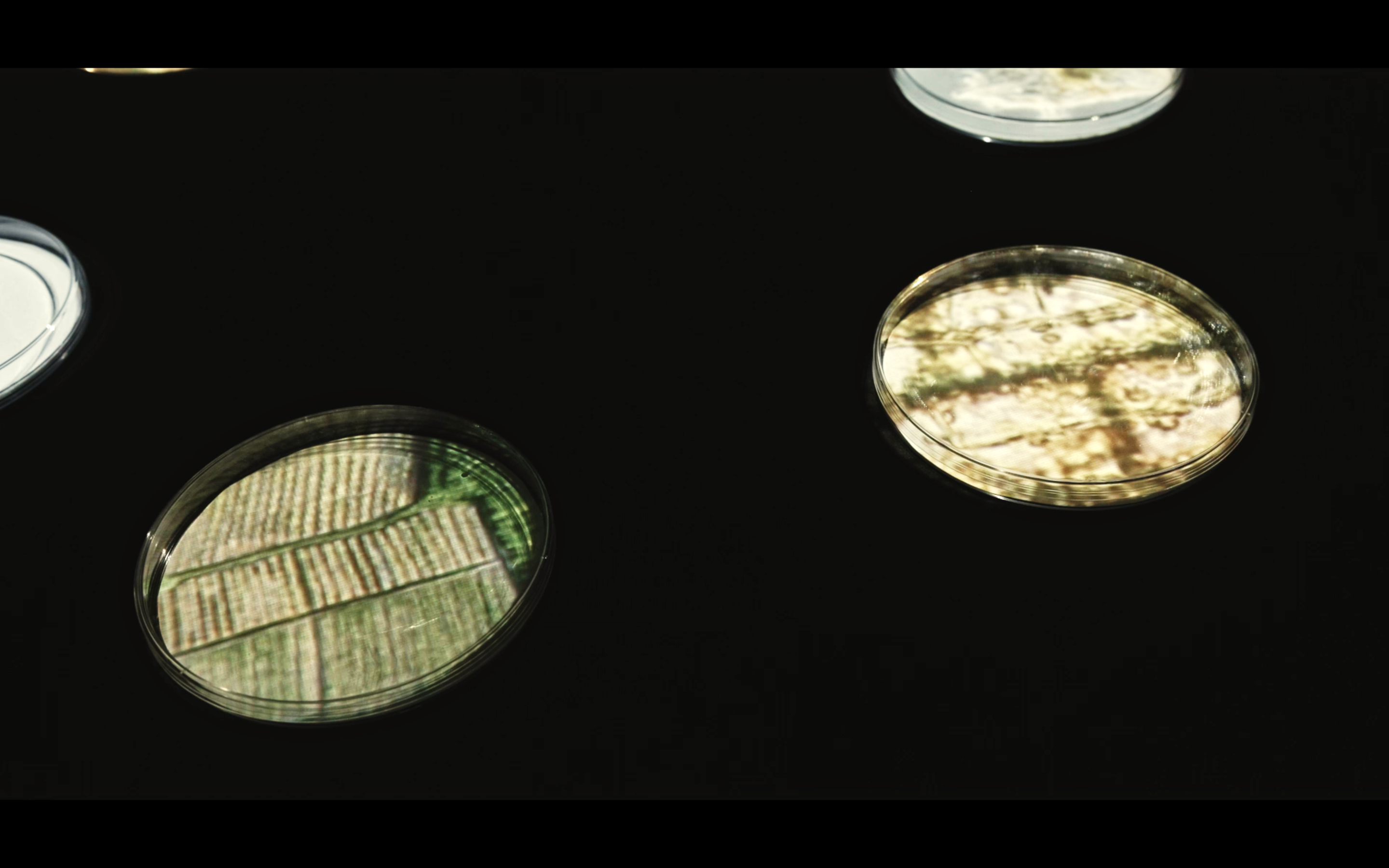
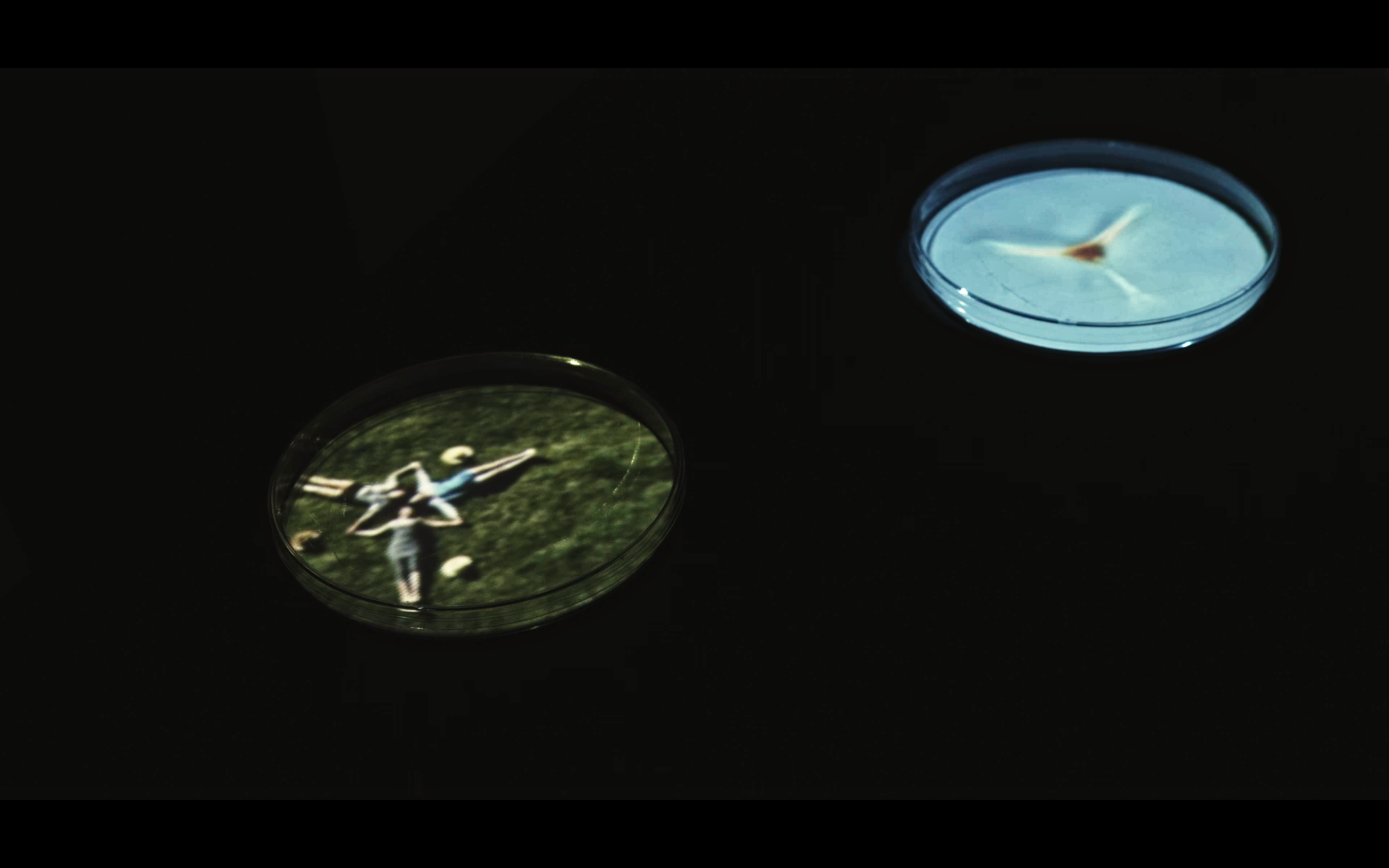
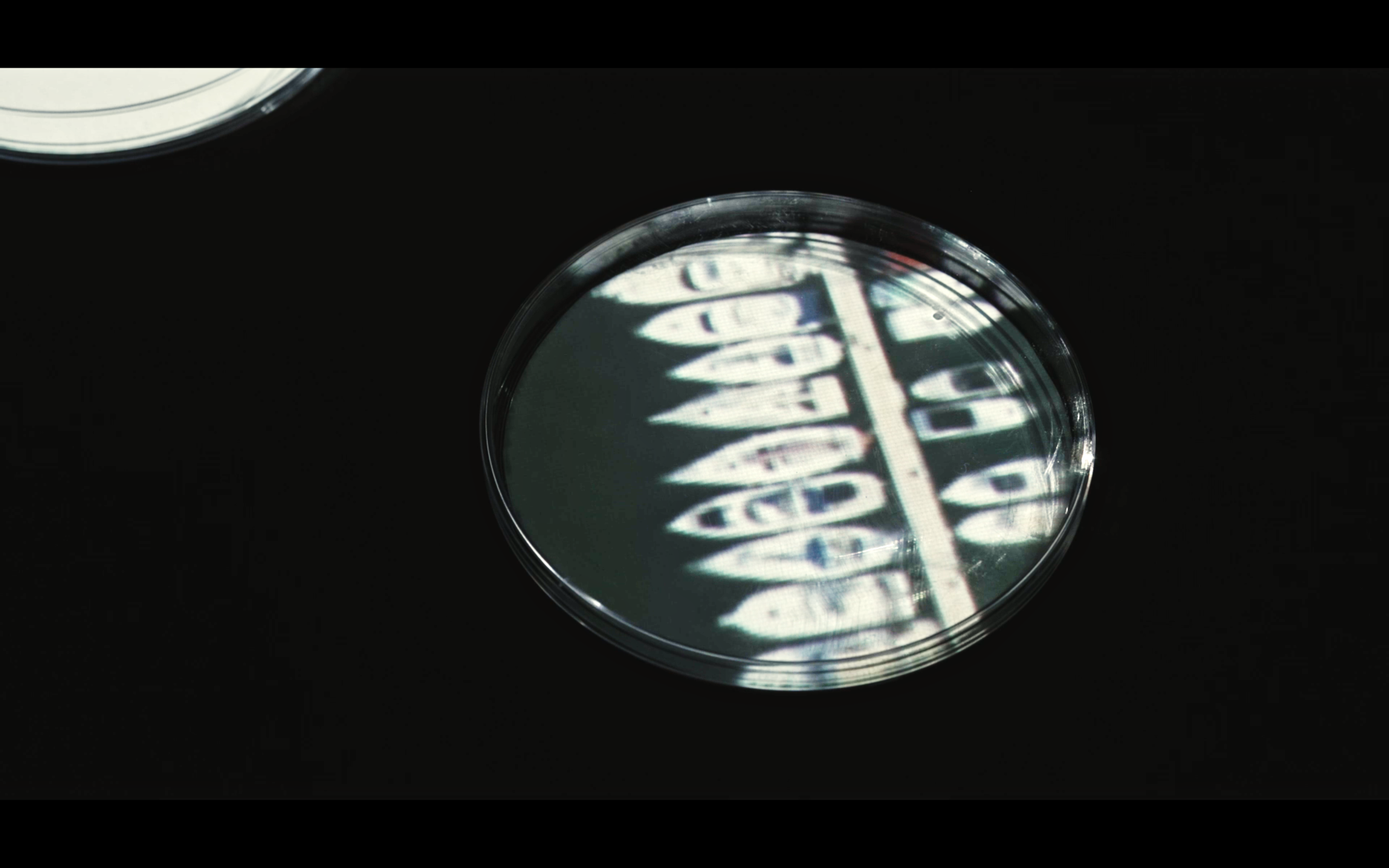
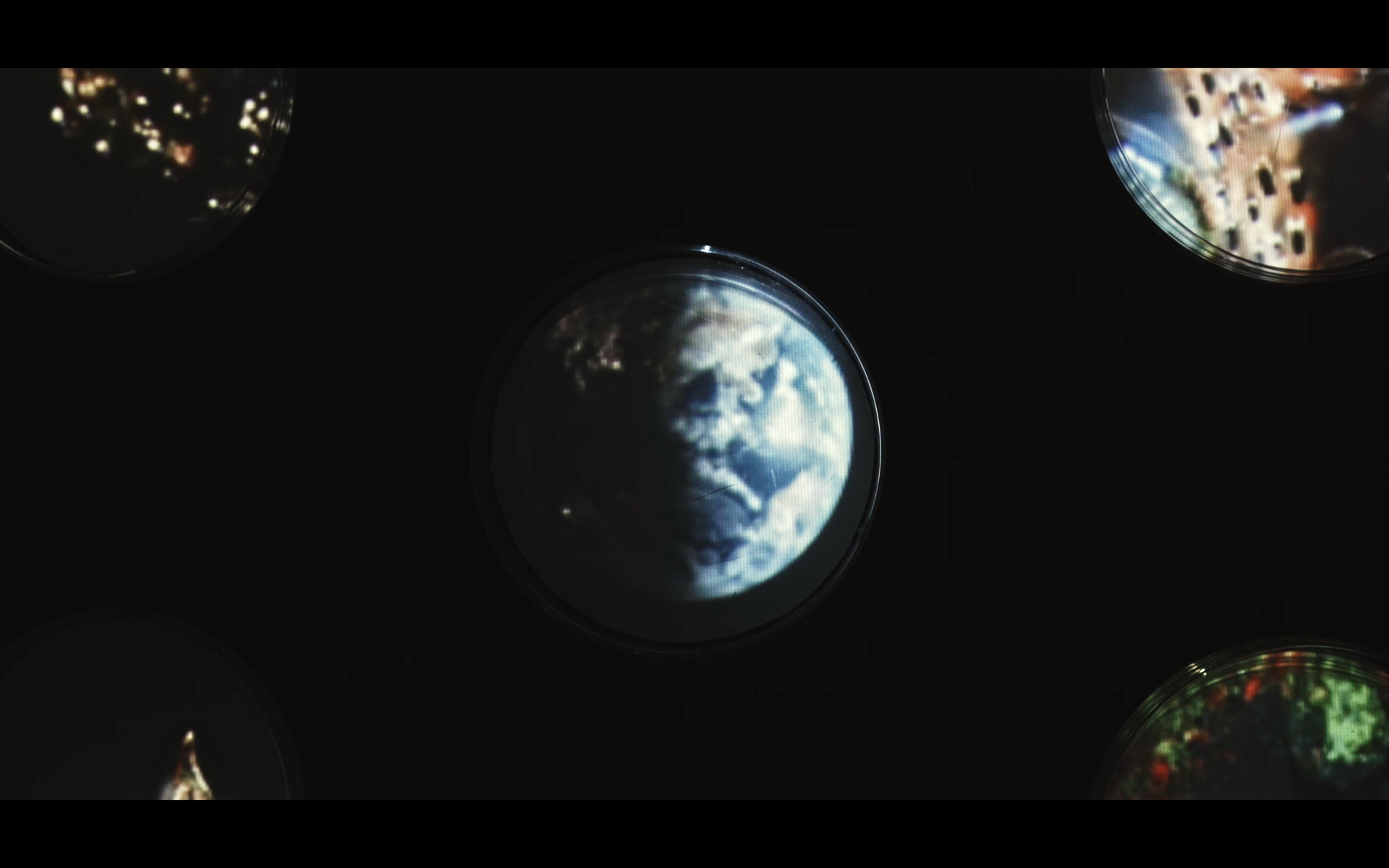
At the center of the installation we find the Earth, intent on its continuous rotation that takes us from day to night. The circadian cycle drives the change of the other projections on the adjacent discs, arranged to compose the symbol of infinity.
Some videos projected inside the Petri discs represent the protagonists of the microscopic world, such as tardigrades, pollen, bacteria, plankton ... while in some others we can se us, human beings, moving in our macroscopic world, but filmed by an external eye of a camera fixed on a drone.
Even the environment in which man lives and moves is shrunk and confined within these small discs suitable for observation: coasts, woods, rivers and roads, illuminated cities, buildings.
We can therefore observe microscopic algae swimming next to human beings intent on taking a bath in a pool.
We can spot intricate ramifications of mold together with the autumn foliage of the Karst, taken from a bird's eye view by the drone.
And again lines of lights that plow the Petri dish in geometric patterns, which we can hardly distinguish as diatoms (small unicellular algae) or cities illuminated at night shot from above.
To add a touch of reality, we may find some fresh bacterial cultures placed inside Petri dishes and a round mirror, to complete the symbol of infinity, through which it is possible to place spectator’s identities within the installation. A further help to destabilize the self-centered view of the world.
A project by Francesco Scarel
Music by Andrea Gulli
The videos and images collected for this installation come from different sources.
Some, concerning plankton, were registered by me at the National Institute of Oceanography and Experimental Geophysics during a 3-day artistic residency, together with artist Stefania Rota and Alfred Beran,a resident research scientist.
The bacterial cultures and real molds were grown in SISSA - International School of Advanced Studies, in particular thanks to Sara Finaurini post doc at the Computational Genomics Laboratory of prof. Remo Sanges and Christina Vlachouli from the technical staff of Neurobiology & Functional and Structural Genomics.
The International Center for Genetic Engineering and Biotechnology (ICGEB) and the laboratory of prof. Zacchigna kindly provided video material regarding their research on cardiomyocytes.
Sara Brandoli, student in the Laboratory of Evolutionary Zoology of Unimore - University of Modena and Reggio Emilia made and kindly provided the videos of the tardigrades.
ASH MEMORIES
July/August 2022: following a long and unusual period of drought, a series of fires devastated some wooded areas of the Karst, a cross-border area between Italy and Slovenia.
The joint intervention of the Italian and Slovenian Fire Brigade, Civil Protection, Slovenian Army, Red Cross, Slovenian Forestry Institute and Forestry Company and the Italian Forest Guard was fundamental in stemming the advance of the flames and avoiding the involvement of some urban areas.
ASH MEMORIES is a virtual reality (VR) installation composed of 3D scans of some areas of the Karst, taken during the weeks following the fires.
Inside a virtual world of black memories, we walk among the remains of destroyed woods and listen to the people who have lived this terrible experience firsthand. The use of VR is therefore not passive: the user is invited to move in the area. The audio interviews are activated only when certain specific areas of the virtual space have been reached.
MEMORY IS NOT A SIMPLE DATA ARCHIVE
Each 3D scan is the restitution of a memory, virtual splinters formed by the blackened bodies of burnt trees. Sharp memories, with angular features and shattered details, which do not want to make us forget what happened.
After all, memory never corresponds perfectly to the reality of lived experiences. Rather, it carries with it only some distinguishable signs of the past, it involves us with different senses and in this way it is capable of bringing the past to the surface of our conscience. Memory is not a simple data archive, but it is something alive that changes with us and modifies our lives.
We believe that memories of this kind, those rising as consequences after a natural disaster, find a common ground in human experiences: our minds are connected in a common sense of sorrow, because, after all, we feel as we are loosing our unique and only Home.
These common feelings are comparable to the ones rising from observing a war scenario. By sharing such evidence, we hope people to become more aware on what to expect in the future years. Increasing awareness by envisioning such scenarios is one of the possible tools (and a powerful one) we can use to move people to act towards a more eco-friendly behavior.
COMMON NATURAL HERITAGE
In ASH MEMORIES, a unique digital material which bears witness to a disastrous series of events, and which tells a story of successful cross-border cooperation. Of course, a story with its difficulties and criticalities, but which has led to the saving of part of the natural common natural heritage of Italy and Slovenia. The joint efforts of local communities, firefighters and civil protection intervening on both sides of the border have created a temporary situation where the border has ceased to exist, allowing common wooded areas and some inhabited centers to be saved.
The affected area covers a surface of just over 4,000 hectares, equal to over 7,000 football pitches. According to researchers from the Environment and Territory group of the Department of Agri-food, Environmental and Animal Sciences of the University of Udine, the first estimate of the damage caused by fires (both on the Italian and Slovenian sides) is over 3700 hectares of burnt woodland, for a volume of 194,000 cubic meters of lost biomass.
The fire has destroyed 32 percent of the forest stock in the areas affected by the fires. The recovery of the burned territories could take between 10 and 20 years.
AWARNESS
The ongoing climate change puts us in front of risks and we must know how to face and prevent. The 2022 fires started following a long and unusual drought that left the Karst dry and vulnerable: but the Italian-Slovenian border area is just a sad example of what could also happen in other places in the world.
Implementing risk prevention measures (for example the maintenance of the undergrowth), and increasing the awareness of the population on this issue, are the challenges that this project intends to face.
ASH MEMORIES aims at increasing awareness of issues such as climate change, biodiversity protection, risk prevention. An answer that aims to build, over time, a scientific citizenship capable of facing, in a constructive and intelligent way, the changes that lie ahead at a social, political, technological and environmental level.
In this case, the “unreal” usually attributed to the virtual, represents a perfect medium to tell a true story, a story of collaboration between men and women, Italians and Slovenians, united to safeguard their common territory.
Expositions
- Immaginario Scientifico Science Center of Trieste - Dec 2022
- AREA SCIENCE PARK - case study for Digital Innovation Hub (Ip4FVG) - Feb 2023
- Scienza e Virgola festival - May 2023
- AESON - Arts in Nature festival - July 2023
- Walk Kras - a walk laboratory organized by Univ. of Architecture and Urban Studies - IUAV, Venice - Sep 2023
- National Convention of Science Communication - Nov 2023
- Among the 25 best candidates for the CMCC Climate Change Communication Award “Rebecca Ballestra” - Nov 2023
- Climate Change prize “The grand challenge” organized by Shylock University Theater Center of Venice in collaboration with University of Ca’ Foscari and Europe Direct Venezia Veneto - Nov 2023
- Diversimili Festival by Kaleidoscienza, Udine - May 2024